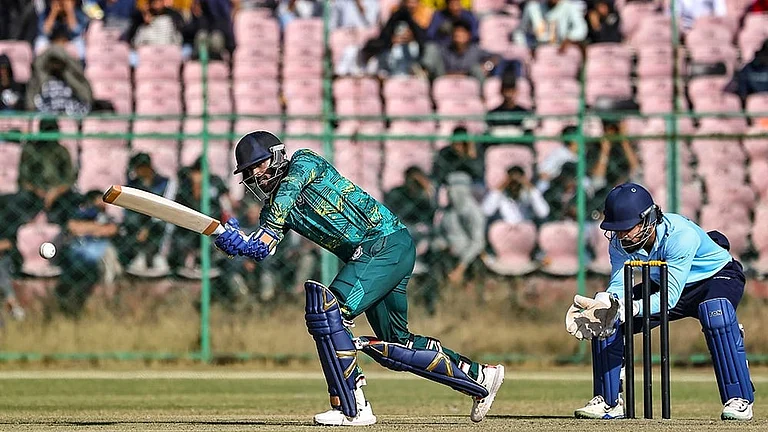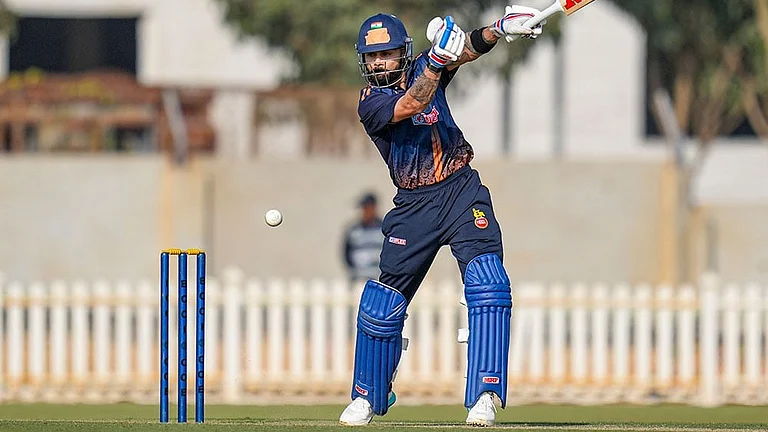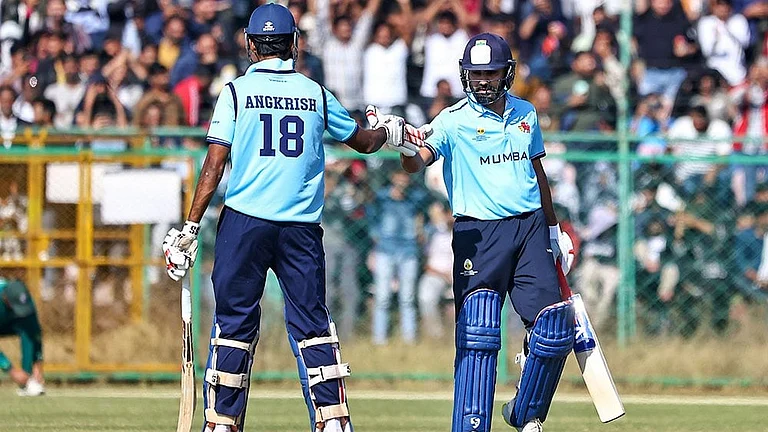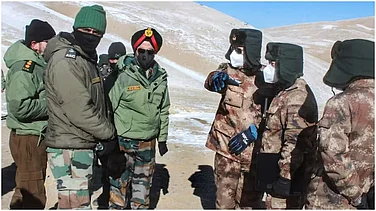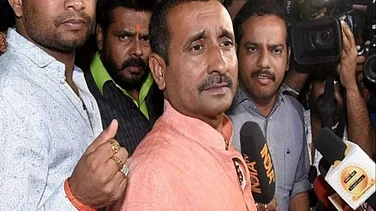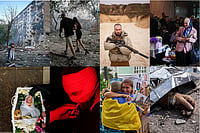"The Pokhran test was a bomb, I can tell you now."—Dr Raja Ramanna in October 1997 on Pokhran-I.
BETWEEN India's first Big Bang in 1974 and the one carried out 24 years later, Dr Ramanna's colleagues at the Bhabha Atomic Research Centre (BARC) have set off hundreds of blasts: Blasts which would not even turn the heads of scientists working outside the High Energy Physics group, but which have spawned a deluge of information on the design of nuclear weapons.
Now, armed with a cache of lethal statistics from these tests on the supercomputer and Pokhran-II, scientists from BARC have joined engineers from DRDO to give finishing touches to the design of an array of nuclear weapons: from miniaturised ones to fit inside short-range missiles and artillery shells that can wipe out battle-tanks, naval frigates and even a battery of artillery guns, to awesome warheads that would reduce military installations or air force bases into a pile of rubble.
Computers—and more precisely the gizmo called ANUPAM, which BARC put together after the US declined to part with the Cray supercomputer—have simulated these nuclear explosions and helped design models and codes for a variety of nukes. With attributes like the quantity of fuel required to cause a catastrophe that would match one set off by thousand tonnes (or a million) of dynamite.
DRDO too has developed a supercomputer, PACEPLUS, to simulate the impact of missiles and other warheads. This will help it club its data with that of BARC to design the weapons. "For gun-type devices, we need a small quantity of the fuel which will be fired down a gun-like barrel to start off a chain reaction which will then cause an explosion and extremely high temperatures," says a DRDO scientist.
The joint capabilities of BARC and DRDO's Pune-based High Energy Materials Research Laboratory and Armament Research and Development Establishment facilities are all in the thick of action. The team is working out secret codes to trigger each warhead, irrespective of whether they fit into artillery shells or tip missiles like Prithvi or Agni. Such electronic codes are essential for the safety of the nuclear warheads not only before the launch, but also until the missile has cruised far enough along the trajectory so that a premature blast does not endanger either the missile itself or an aircraft flying into its range. On the scientists' agenda: a bomb which can fit into a cart. Such a bomb could be camouflaged and smuggled across the border, and activated with a remote device only if India decides to employ a nuclear weapon against an adversary.
Moreover, India's stockpile now includes enough weapons-grade plutonium to make at least 100 nuclear bombs, say ministry of defence sources. It's a figure that almost matches estimates drawn up by the Stockholm International Peace Research Institute (SIPRI) on the basis of production of plutonium by the Cirus and Dhruva reactors. In addition to weapons-grade fuel adequate for 70 to 100 bombs, SIPRI pointed out, India has a tonne of reactor-grade plutonium in storehouses built at nuclear reactors across the country.
There is, however, a major drawback. In order to mount a nuclear attack, India would have to bank on jet fighters like the Mirage 2000 or Sukhoi 30, or artillery guns. The reason: DRDO is still grappling with problems associated with rolling out battle-ready Prithvi and Agni missiles. The missile is powered by a liquid propellant which is dangerous and highly corrosive, and therefore, ought to be handled with extreme care. According to DRDO sources, it would take an hour or 90 minutes to load the missile with this propellant and move it close to the border in order to strike targets deep inside an adversary's territory. During warfare, this is a critical time period for the 333rd Missile Group of the Indian army.
A large retinue of vehicles such as four transporter-erector-launcher vehicles (TELs) and support vehicles for maintenance, transport, fuel and communications make these missiles vulnerable to pre-emptive strikes—specially during the long fuelling time. Moreover, these missiles would be under constant enemy surveillance since they will have to be deployed close to the border in view of their limited range of 150 to 250 km.
In battlefield conditions, the other factor that could come in the way of a successful launch of Prithvi is India's limited experience with the missile system—which also adds to its vulnerability. The missile has been put through only 15 tests so far, a figure which is inadequate to declare a missile as proven and worthy of deployment for battlefield support or for destruction of airfields and military command stations. "The Soviet SS-N-4 missile employs the same fuel as Prithvi, and has a success rate of 0.72. The reliability of Prithvi may be a greater problem than the Soviet missiles because our missile has been tested over a limited number of trials," says a source.
Besides these operational hurdles, Prithvi would have to maintain an accurate flight path and penetrate defences to strike targets with almost pinpoint accuracy. But, according to insiders, in order to demolish even a single military command centre with precision strikes, the Indian Army would require a stockpile of Prithvis far more than currently available.
AGNI, the intermediate range ballistic missile, also has hitches in preparedness because of fuel and range problems. This missile has been tested only thrice, the last being in February 1994. Since then, the project has been put on hold, with little efforts to increase its range to 2,500 km, or to work on the terminal guidance for improved accuracy and a perfect re-entry system in order to ensure that the missile does not burn up during flight. "We need eight to 10 tests to verify Agni's effectiveness and to improve its CEP (circular error probable) for high levels of accuracy," the source said. Such elaborate tests would apparently require substantial funds in the next few years.
The good news, however, is that the shortfalls of both Prithvi and Agni can be offset by the total weapon load capacity of the 900-odd fighters of the Indian Air Force. These fighters together could match the capabilities of at least 3,000 Prithvi-I missiles (range of 150 km) or 6,000 Prithvi II missiles (range of 250 km). Besides, Pakistan does not have many Surface to Air (SAM) missiles capable of shooting down high-flying planes. Added to this is the advantage of costs. One US study, comparing ballistic missiles and air strikes, estimates the cost per tonne of explosives delivered to be $1.25 million and $0.74 million respectively.
Besides the computer simulation and projects to design nuclear weapons, DRDO laboratories have also developed an antidote to nuclear radiation as part of its programme on nuclear-biological-chemical (NBC) warfare. Developed by DRDO's Gwalior and New Delhi centres, it has been cleared for use after extensive tests on plants and animals. "We worked on the antidote because it's a must for the mechanised infantry. Of course, it will be made available to civilians should someone use a bomb on us. It helps soldiers withstand radiation several times more than normal levels, thus reducing the casualty factor. It also delays the onset of damage from radiation to human organs," said a top source in the ministry of defence. However, those in the vicinity of an explosion obviously stand no chance of survival.
The antidote, according to sources, is the fruition of seven years of research for a drug that could protect the infantry in desert warfare. While no details of the antidote are available, a leading radiation oncologist claimed that it may belong to the class of chemicals called anti-oxidants. Research is under way in the US to develop ways of using these chemicals to protect normal tissues from radiation in cancer patients. They are relatively safe with no side-effects, but little is known about them.
Clearly, the monopoly of a handful of nations which have been stockpiling nuclear weapons has now been broken. Both with regard to NBC warfare, as well as the methods to contain the damage.








